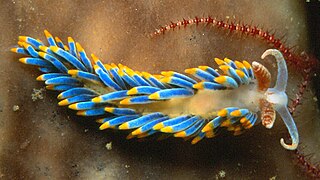
Nudibranchs are a group of soft-bodied marine gastropod molluscs that shed their shells after their larval stage. They are noted for their often extraordinary colours and striking forms, and they have been given colourful nicknames to match, such as "clown", "marigold", "splendid", "dancer", "dragon", and "sea rabbit". Currently, about 3,000 valid species of nudibranchs are known.

Sea slug is a common name for some marine invertebrates with varying levels of resemblance to terrestrial slugs. Most creatures known as sea slugs are gastropods, i.e. they are sea snails that over evolutionary time have either completely lost their shells, or have seemingly lost their shells due to having a greatly reduced or internal shell. The name "sea slug" is most often applied to nudibranchs, as well as to a paraphyletic set of other marine gastropods without obvious shells.

Glaucus atlanticus is a species of small, blue sea slug, a pelagic (open-ocean) aeolid nudibranch, a shell-less gastropod mollusk in the family Glaucidae.

Metarminoidea is a provisional taxonomic superfamily of colourful sea slugs, aeolid nudibranchs, marine opisthobranch gastropod molluscs in the clade Nudibranchia.

Glaucus marginatus is a species of small, floating, blue sea slug; a pelagic (open-ocean) aeolid nudibranch; a marine opisthobranch gastropod mollusc in the family Glaucidae. This species is closely related to Glaucus atlanticus, and is part of a species complex along with Glaucus bennettae, Glaucus thompsoni, and Glaucus mcfarlanei. Like Glaucus atlanticus, it is commonly known as a blue dragon.
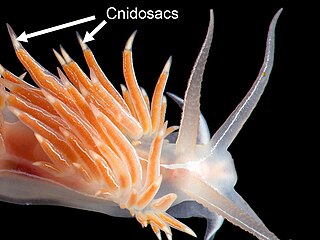
Cerata, singular ceras, are anatomical structures found externally in nudibranch sea slugs, especially in aeolid nudibranchs, marine opisthobranch gastropod mollusks in the clade Aeolidida. The word ceras comes from the Greek word "κέρας", meaning "horn", a reference to the shape of these structures.
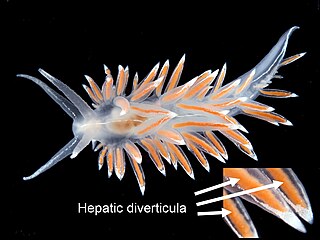
As applied to mollusks, the Neo-Latin term diverticulum is an anatomical feature. The term is most often encountered in the plural form as "diverticula", "hepatic diverticula", or "digestive diverticula", which are anatomical terms for organs which are visible from the outside of the body in a clade of sea slugs known as aeolid nudibranchs, marine opisthobranch gastropod molluscs.

Aeolidia papillosa, known as the common grey sea slug, is a species of nudibranch in the family Aeolidiidae.

The purple lady nudibranch, Paraflabellina funeka, is a species of aeolid nudibranch, and is a very colourful sea slug. It is a marine gastropod mollusc in the family Flabellinidae.

The white-edged nudibranch, Coryphella capensis, previously known as Fjordia capensis, is a species of sea slug, specifically an aeolid nudibranch, a colourful sea slug. It is a marine gastropod mollusc in the family Coryphellidae.

Trinchesia speciosa, common name the "candy nudibranch", is a species of sea slug, an aeolid nudibranch, a marine gastropod mollusc in the family Trinchesiidae.
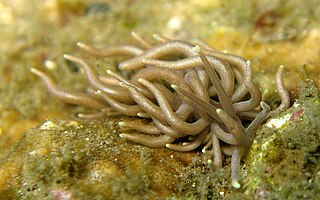
Phyllodesmium is a genus of predatory sea slugs, aeolid nudibranchs, marine gastropod molluscs in the family Facelinidae.

Phyllodesmium crypticum is a species of sea slug, an aeolid nudibranch, a marine gastropod mollusc in the family Facelinidae.

Glaucus is a genus of small blue pelagic sea slugs. They are aeolid nudibranchs, ranging in size from 20 to 40 mm. They feed on colonial cnidarians such as Portuguese man o' wars, blue buttons, and purple sails. They can produce painful and potentially dangerous stings when handled, as they store the venomous nematocysts of their prey. Glaucus is the only genus in the family Glaucidae. It includes five species.

Pteraeolidia ianthina is a sea slug, an aeolid nudibranch in the family Facelinidae. It is known as a blue dragon, a name it shares with Glaucus atlanticus and Glaucus marginatus.
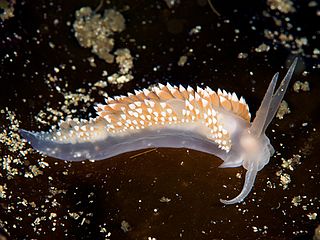
Coryphella verrucosa, is a species of sea slug, an aeolid nudibranch, a marine gastropod mollusc in the family Coryphellidae.

Coryphellina rubrolineata is a species of sea slug, an aeolid nudibranch, a marine heterobranch mollusc in the family Flabellinidae.

Piseinotecus soussi is a species of sea slug, an aeolid nudibranch, a marine gastropod mollusc in the family Piseinotecidae.

Aeolidiella alderi is a species of sea slug, an aeolid nudibranch in the family Aeolidiidae. It is native to northwestern Europe where it occurs in the intertidal zone. It is a predator and feeds on sea anemones.
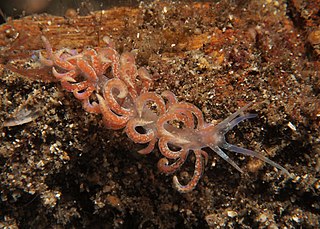
Phyllodesmium poindimiei is an Alcyonacea feeding, aeolid nudibranch Gastropod belonging to the family Facelinidae. Cerata are important in this clade in terms of their physical defense and efficient metabolic processes. This species is spread sporadically along tropical coastal regions such as Australia, Hawaii, and the Indo-Pacific living in diverse marine habitats such as coral reefs. Unlike other species in the Opisthobranch Mollusca clade, P. poindimiei’s lush pink cerata are used for defensive purposes other than Nematocyst (dinoflagellate) capture and toxin release. Organismal ties within these thriving, tropical ecosystems can be determinants of environment change, which affects massive coral ecosystems. Continuously changing marine ecosystems, such as coral reefs, are directly linked to the evolution of organisms that live and thrive in the tropics such as the soft nudibrach P. poindimiei.





















